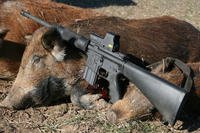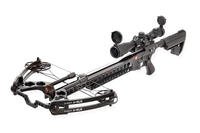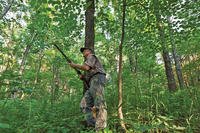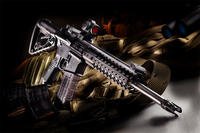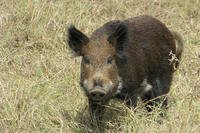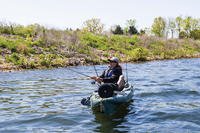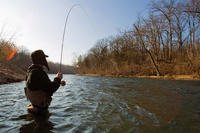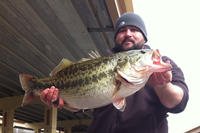Exhaust silencers take the snap, crackle and pop out of ATVs/UTVs.
by Bruce W. Smith
Run silent, run deep. That's the basic operating premise of submariners around the world and it was immortalized in 1958 when Clark Gable and Burt Lancaster starred in the famous movie of the same name. Water is a very efficient carrier of sound so noise can be easily detected by the keen hearing of both prey and predator. To succeed in the hunt, the predator must be stealthier than the prey.
The outdoors is much like the ocean. Although most land predators have excellent vision, they also have finely-tuned hearing as part of nature's survival system. The snap of a twig, the rustle of leaves, or the roar and crackle of an exhaust instantly puts them on full alert. When unusual noises enter their domain, they leave — quickly and quietly to avoid the threat.
Successful predator hunters understand this and take measures to make their audible footprint as small as possible. The first, and most important, step is making their entry into the hunting area as quiet as possible. Many hunters are using ATVs to get in and out of their hunting country, and some older hunters actually call and hunt from an ATV. Here are some tips on how they do it.
Exhaust Silencers
Exhaust silencers either replace the existing muffler or are added on to the factory muffler. Some are welded on, some bolted, some just press fit to the existing muffler. The end result is a significant reduction in noise — especially the snapping and popping that is a signature of larger, more powerful ATV and side-by-side engines.
Today's four-stroke gas engines are good candidates for silencers, which do a good job making them stealthier. Diesels, unfortunately, don't get the full stealth benefit because the engine itself is noisy as the loud clattering is emitted from within the cylinder and block — not through exhaust.
Quieting exhaust noise is accomplished in two ways: The old way is to add more baffles and sound-deadening material into the flow of the exhaust to muffle the sound. The modern way is to re-route the sound waves inside the muffler so they interfere with each other and cancel themselves out. The old way is a bit more restrictive in exhaust flow, and thus robs the engine of a few percentage points in power. The other allows a more free-flowing exhaust with little, if any, change in power.
My testing shows neither exhaust type makes a noticeable seat-of-the-pants power difference when you are on the trail. One or two horsepower won't be felt by the average rider.
What is noticeable is a significant reduction in the snap, crackle and pop of the engine as you drive to your hunting site. A stealthy approach means your prey is less likely to vacate the area.
There are claims for percentages and decibel (dB) reduction. In general a 10dB noise reduction is the equivalent in reducing the sound you hear by about half. Sound comes in a lot of forms and in a very, very wide range of frequencies.
Exhaust silencers can't cover all the sound ranges, and the manufacturers are not held to any measuring standard. To compare apples-to-apples, you'll probably have to rely upon phone calls to the manufacturer to see how far away from the exhaust tip they take their measurements to get comparable results.
I favor the modern approach that uses sound-cancellation design to make the exhaust stealthier over silencers that use baffles and sound-deadening materials.
You pay more for the new tech, and with money being tight that could make a difference in what design you favor.
The Players
Exhaust silencers are plentiful through e-tailers and ATV retailers. But there are only a few actual manufacturers.
One of the most well-known is Benz Silent Rider ($159), which is a bolt-on/weld-on/press on design using baffles and packing. It is U.S. Forest Service (USFS) spark-arrestor-approved with heat shielding. Benz (www.atvsilencer.com; 866-394-2878) claims their testing shows the addition of the Silent Rider silencer only increases exhaust backpressure by 2 percent, which creates a negligible loss of power.
What is cool about Benz is they offer a 60 day, no questions asked money-back guarantee just to try their system. All Benz products have a one year warranty on any type of manufacturer defect.
A new player in the exhaust silencer field is Kolpin (www.kolpin.com; (877) 956-5746), a company known for ATV/UTV accessories. The Kolpin Powersports ATV Exhaust Muffler Kit, which is chambered and baffled, is said to reduce the noise of your machine by up to 50-percent. Kolpin says their Stealth 2.0 system ($170; $260 in stainless steel) is a "one size fits all" silencer that is U.S. Department of Agriculture (USDA) approved and does not adversely affect the engine or significantly decrease performance.
Kolpin Power Sports is up front in noting they take the sound measurements 8-10 feet from the exhaust and the 5dB reduction is "about the equivalent" of a 50 percent reduction in rider/driver perceived noise.
More importantly, the Kolpin silencer design doesn't increase backpressure, which can have an adverse effect on the newer electronic-fuel-injected engines where the on-board computer senses such changes and adjusts the air/fuel mixture accordingly.
Another new silencer manufacturer is automotive exhaust maker Flowmaster, which markets their stainless steel ATV exhaust system under the Hushpower (www.hushpower.com; 877-394.2878) brand. This is a "Universal Fit" silencer for most makes and models of ATVs and side-by-sides, and it utilizes their unique and patented Hushpower Wide Spectrum Sound Cancellation technology.
Hushpower ATV silencers ($200) easily connect to your ATV's existing muffler, and are said to reduce sound levels by up to 10db — a real 50 percent reduction in sound — without any loss of power or increase in backpressure. They currently offer 13 models available for Honda, Yamaha, Polaris, Bombardier and Arctic Cat, plus a universal model, which fits many other and earlier ATV's.
Those who live in the rust belt or along the coasts will like the insulated Cool Shell case made of rugged 18- gauge stainless steel, while the internal core is made of perforated T409 stainless steel for durability. Hushpower silencers come with a 3-year warranty.
Regardless of which silencer you slide on to your ATV's or side-by-side's factory exhaust system you'll be a whole lot more stealthy heading into predator country where ever-alert ears are just waiting to hear your approach.
Going Undercover: A Great Hide for Your ATV/UTV
Being stealthy getting in to the hunting area is just one aspect of being a successful predator hunter. Keeping out of sight once you get to the location is even more important. One way to keep your visibility from wary eyes is to utilize terrain and camouflage to mask your presence.
Camo does a great job hiding you. But what about your ATV? The body may be camouflaged but the hard edges of the fenders and roll cage don't look right to critters that survive by knowing what looks natural and what doesn't.
A good solution is to put both yourself and you ATV under cover. Camo netting is available from military surplus stores and it can be purchased new or used with prices starting at less than $30 for a 10x10-foot version that'd cover you and a quad. Larger nets, which would cover a side-by-side and two hunters can be had for less than $100.
These nets are light in weight and pack small so they can easily be stored in the bed of your side-by-side or in a cargo bag of an ATV. Limbs can be used to provide a little height — or you can go to tent parts suppliers on the Internet to purchase collapsible fiberglass tent poles to configure the height and profile of your cover however much is needed for the terrain and hunting conditions.
However, game laws in your state may not allow you to use an ATV/UTV in such a manner. We queried a number of game wardens around the country and received a wide range of answers about using an ATV as part of a camouflaged blind and utilizing it as a gun rest.
"Shooting from the ATV would be illegal in Utah," says Mike Fowlks, Chief of Law Enforcement for the Utah Division of Wildlife Resources. "There are exceptions for disabled hunters but illegal for most people. There may be some vagueness in the law with regards to using the vehicle as a bench rest, but I believe there are many courts that would rule this as illegal as well."
Utah's state game warden, Captain Cameron Waithman, says it is legal to use your ATV/UTV as a blind "however it would be unlawful to use it as a gun rest as that would be a violation for having a loaded gun on a vehicle. The exception would be if the hunting was on private property where it is legal to carry a loaded firearm in or on a vehicle."
"It is legal to use your ATV as a stand to hunt in Mississippi, offers Major Lane Bell, Mississippi Law Enforcement. "Our motorized vehicle law says: It is illegal to shoot at any wild animal, or bird from a motorized vehicle or motorized conveyance unless the progress from such vehicle or conveyance has completely ceased."
Nebraska has similar views of hunters using ATVs. "Nebraska doesn't have any game law restricting that activity. So you can use an ATV as part of a blind and use it as a gun rest as long as you're not shooting game birds (such as pheasant, quail turkeys, doves etc.)," explains Murray Johnson of the Nebraska Game & Parks Commission's Wildlife Division.
Jonathan Stephens with the Wyoming Game and Fish department responded with the following, "In Wyoming a person can legally build/construct a blind around an ATV/UTV when hunting predatory animals. However, it may be worth noting that the take (harvest/kill) of certain animals will dictate not only where one can set up a blind but also from where one can shoot."
So check your local hunting regs closely before putting yourself and your transportation under cover.
